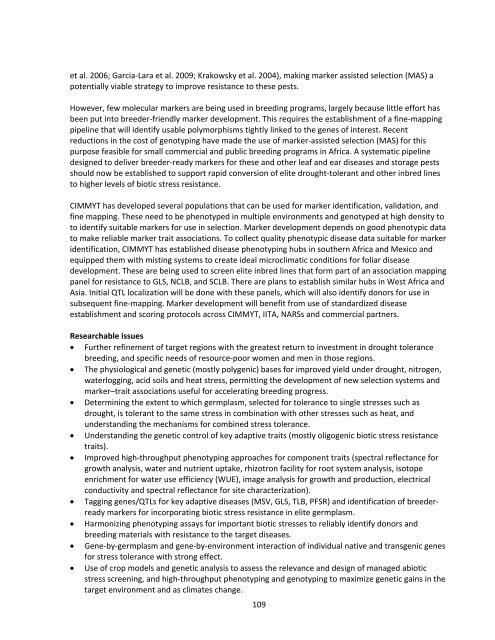Download - Maize
Download - Maize
Download - Maize
Create successful ePaper yourself
Turn your PDF publications into a flip-book with our unique Google optimized e-Paper software.
et al. 2006; Garcia‐Lara et al. 2009; Krakowsky et al. 2004), making marker assisted selection (MAS) a<br />
potentially viable strategy to improve resistance to these pests.<br />
However, few molecular markers are being used in breeding programs, largely because little effort has<br />
been put into breeder‐friendly marker development. This requires the establishment of a fine‐mapping<br />
pipeline that will identify usable polymorphisms tightly linked to the genes of interest. Recent<br />
reductions in the cost of genotyping have made the use of marker‐assisted selection (MAS) for this<br />
purpose feasible for small commercial and public breeding programs in Africa. A systematic pipeline<br />
designed to deliver breeder‐ready markers for these and other leaf and ear diseases and storage pests<br />
should now be established to support rapid conversion of elite drought‐tolerant and other inbred lines<br />
to higher levels of biotic stress resistance.<br />
CIMMYT has developed several populations that can be used for marker identification, validation, and<br />
fine mapping. These need to be phenotyped in multiple environments and genotyped at high density to<br />
to identify suitable markers for use in selection. Marker development depends on good phenotypic data<br />
to make reliable marker trait associations. To collect quality phenotypic disease data suitable for marker<br />
identification, CIMMYT has established disease phenotyping hubs in southern Africa and Mexico and<br />
equipped them with misting systems to create ideal microclimatic conditions for foliar disease<br />
development. These are being used to screen elite inbred lines that form part of an association mapping<br />
panel for resistance to GLS, NCLB, and SCLB. There are plans to establish similar hubs in West Africa and<br />
Asia. Initial QTL localization will be done with these panels, which will also identify donors for use in<br />
subsequent fine‐mapping. Marker development will benefit from use of standardized disease<br />
establishment and scoring protocols across CIMMYT, IITA, NARSs and commercial partners.<br />
Researchable issues<br />
Further refinement of target regions with the greatest return to investment in drought tolerance<br />
breeding, and specific needs of resource‐poor women and men in those regions.<br />
The physiological and genetic (mostly polygenic) bases for improved yield under drought, nitrogen,<br />
waterlogging, acid soils and heat stress, permitting the development of new selection systems and<br />
marker–trait associations useful for accelerating breeding progress.<br />
Determining the extent to which germplasm, selected for tolerance to single stresses such as<br />
drought, is tolerant to the same stress in combination with other stresses such as heat, and<br />
understanding the mechanisms for combined stress tolerance.<br />
Understanding the genetic control of key adaptive traits (mostly oligogenic biotic stress resistance<br />
traits).<br />
Improved high‐throughput phenotyping approaches for component traits (spectral reflectance for<br />
growth analysis, water and nutrient uptake, rhizotron facility for root system analysis, isotope<br />
enrichment for water use efficiency (WUE), image analysis for growth and production, electrical<br />
conductivity and spectral reflectance for site characterization).<br />
Tagging genes/QTLs for key adaptive diseases (MSV, GLS, TLB, PFSR) and identification of breederready<br />
markers for incorporating biotic stress resistance in elite germplasm.<br />
Harmonizing phenotyping assays for important biotic stresses to reliably identify donors and<br />
breeding materials with resistance to the target diseases.<br />
Gene‐by‐germplasm and gene‐by‐environment interaction of individual native and transgenic genes<br />
for stress tolerance with strong effect.<br />
Use of crop models and genetic analysis to assess the relevance and design of managed abiotic<br />
stress screening, and high‐throughput phenotyping and genotyping to maximize genetic gains in the<br />
target environment and as climates change.<br />
109

















